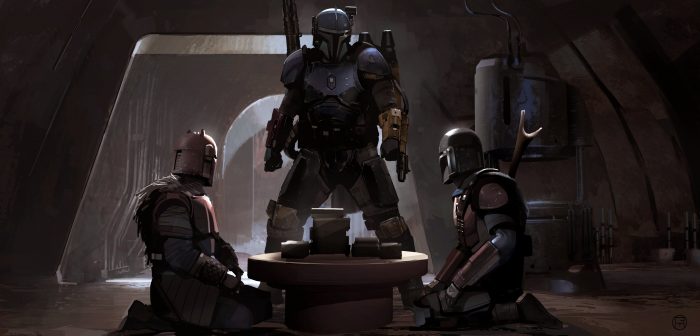Always Wear Your Helmet: ‘The Mandalorian’ Brings Up More Questions About Mandalore’s Fate in the ‘Star Wars’ Universe

The name Mandalore has been barely brought up in The Mandalorian, yet it haunts the post-war proceedings of the Disney+ Star Wars series. The fate of the Mandalorian homeworld is insinuated by references to “The Great Purge” and the Mandalorians’ devotion to never removing their helmets.
“Chapter 3: The Sin” unravels more about the fractured state of Mandalorian culture and history. The titular Mandalorian, played by Pedro Pascal, confronts his own betrayal of honor, remarking, “My armor has lost its integrity. I may need to start over.” He sees his rebirth in his new armor, and sets out to atone for that titular sin.
Chapter 1 and 3 emphasize that this lone wolf has a pack, even if he is a bit of a pariah. When he visits his Mandalorian enclave to have his new armor forged from his Empire blood money, his brethren react with disgust. How can one of their own collaborate with the Empire, the very oppressive force that terrorized Mandalore and coopted their Mandalorian traditional metals, the beskar? How can he wear the beskar the Empire pilfered from this “Great Purge”?
The Armorer (Emily Swallows), the elder of his Mandalorian tribe, rules that the Imperial-printed metal is “back with its tribe,” and therefore represents the restoration of order despite the unscrupulous acquisition. She mediates the conflict by asking the Mando if he or anyone else has removed his helmet. He gives his honest, “No.” She and the other Mandalorians let him be with a mantra: “This is the way.” As long as he has always worn his helmet, the elder does not view him as an outcast.
When a viewer first hears “Is it true you guys never take off your helmets?” in Chapter 1, it feels like a lean-in into a mythic misconception rather than a realized tradition. But the Armorer’s words confirm, yeah, Mandos do always wear the helmet, or at least, this Mandalorian Cobra faction we see.
Newcomers of the Star Wars universe are learning the rules of this culture as they go in The Mandalorian. But Star Wars viewers familiar with previous depictions of Mandalorians from the various animated shows may pick up on more wounding layers. Before The Mandalorian, Mandalorians on the television screen consistently removed their helmets without receiving a berating from their brethren—see the animated The Clone Wars and Star Wars Rebels series. Even Mandalorian warrior extremists like Death Watch (fun fact: The Mandalorian creator Jon Favreau voiced the leader, Pre Vizsla) are seen with their faces clear. In Rebels, influential Mando figures, such as Fenn Rau and Countess Ursa Wren, are introduced without their helmets. In fact, the Rebels finale ends on the image of a young Mandalorian girl without her helmet as the Galactic Civil War is wrapping up. But these moments exist within the Prequel and Original Trilogy era.
Clearly, keeping the Mandalorian’s helmets on is both a thematic and tonal choice on Favreau’s part to keep up the mystique. Why do Mandalorians—or at least these Cobras—emphasize never removing the helmet? Does this signify a post-war cultural shift for surviving warrior Mandalorians? Are surviving warrior clans and houses clinging tighter to their heritage in response to the Great Purge? (It’s also important to keep in mind that a large population of Mandos did not wear beskar armor or helmets during the pacifist, anti-warrior New Mandalorian rule in The Clone Wars.)
Werner Herzog’s The Client character remarks that it’s hard to find Mandalorians these days. Chapter 1 already hinted upon the reclusiveness of Mandos, but Chapter 3 hammers in that they’re more secluded and come out one at a time.
Think about the last time significant Mandalorian history played out in the canon. In Rebels, a Mandalorian rebellion sought to defeat the Empire’s influence off their homeworld. After Lady Bo-Katan took up the legendary Darksaber, and thus the ruling title of Mand’alor to lead Mandalorians into rebellion against the Empire during the Galactic Civil War, what happened? Rebels departs from the Mandalorian arc with an open-ended hopeful note, with the understanding that Lady Bo-Katan will lead Mandalorians into victory.
However, if there’s anything the Great Purge indicates, Bo-Katan’s Mandalorian rebellion did not go well or couldn’t prevent the Great Purge. Where is Lady Bo-Katan, who essentially was the last known ruler of Mandalore? Where is the mythic Darksaber?
All we know now is that Mandalorians are spread thin across the galaxy, living in the shadows and barely emerging into the public eye of civilization. They are replenishing their population through adoption, sponsoring Foundlings because “They are the future.” The concept of Mandalorian adoption goes back to the Legends era before Disney acquired the Star Wars property, known as “Gai bal manda” (“name and soul”). Our Mando says, “I was once a Foundling,” indicating that he was adopted—not born—into the Mandalorian tribe. In the glimpses of his flashbacks, an unmasked boy flees with his family, implying that he later took up the Mandalorian culture and the helmet.
As the Mando flies off to his next adventure, time will tell how much more we learn about Mandalore and the Purge. If we do, it’s not going to be pretty. Regardless, the Mandalorians keep Mandalore alive through wearing the beskar and adopting Foundlings. If it’s any indication, the Mandalorian is now raising a Foundling and he’s still keeping that helmet on.
The post Always Wear Your Helmet: ‘The Mandalorian’ Brings Up More Questions About Mandalore’s Fate in the ‘Star Wars’ Universe appeared first on /Film.
from /Film https://ift.tt/2KXqXTu
via IFTTT
Comments
Post a Comment